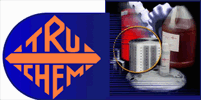

|
T.C. 30-LV |
||||||
|
||||||
 |
 |
|
| MISSION STATEMENT | HOME |
|
|
T.C. 30LV prevents overpickling of steel. . . And corrosion of profits! When acid pickling of steel is controlled to remove scale and rust and stops right there, that's a good thing. But when pickling goes on uncontrolled, consuming metal, consuming acid and promoting embrittlement, that's like any overdose - a good thing gone wrong. Overpickling is easy to prevent. The addition of a tiny amount of T.C. 30LV - a mere 0.1% to 0.5% by weight of the concentrated sulphuric acid - acts to set up a protective buffer between acid and metal: The acid is free to attack rust and scale but is inhibited from attacking the metal. By this action T.C. 30LV saves money in many ways. One way, the savings on acid consumption alone, may even pay for the entire cost of adding T.C. 30LV. If you're pickling steel with raw acid, look at the list of advantages you get by adding T.C. 30LV to the pickle. If you're using an inhibitor, check to see if you're getting all of the advantages you get with T.C. 30LV. PRIMARY APPLICATION T.C. 30LV is a liquid material designed to inhibit sulfuric acid pickling solutions from attack on sound metal. By decreasing the iron build-up in the pickling bath, the addition of T.C. 30LV reduces acid consumption by as much as 30% to 40%. By the same token, metal loss is reduced and the life of the acid bath is prolonged. Added to either hot or cold, batch or continuous sulfuric acid pickling solutions. T.C. 30LV produces a controlled foam blanket, which reduces fumes. Additionally, it assures better rinsing. ADVANTAGES OF T.C. 30LV
Reduces metal embrittlement caused by penetration of hydrogen gas into the metal CHEMICAL CHARACTERISTICS
APPLICATION PROCEDURE T.C. 30LV has an acid base. It may, therefore, be added directly to the sulfuric acid concentrate when making up or adding to the pickling solution; or it may be added directly to the diluted pickling solution, hot or cold, and agitated. Normal handling precautions for highly acidic materials should be observed. Rubber gloves, safety goggles or face shield, and protective clothing should be worn. Normal use range of T.C. 30LV is from 0.1% to 0.5% by weight of the concentrated acid, although in practice acid and additive are proportioned by volume measure. As a convenience, the table below converts weight units into volume units.
*Although 60°Be is lower in concentration than 66° Be, more of the former is, of course, added to obtain solutions of equivalent strength. Thus, the amount of T.C. 30LV is the same of both acids. NOTE: If a concentration of T.C. 30LV greater than 0.5% by weight of acid is employed, or if there is too much mechanical agitation of the inhibited pickling bath, excessive foam may develop. When steel is pickled prior to phosphating, electroplating, tinning or galvanizing, the film deposited by the inhibitor should first be removed and the surface neutralized. A solution of T.C. PH Booster is excellent for this purpose. The table below indicates the concentrations required to prepare a 3785-liter (1000 gallon) pickling solution:
NOTES ON USE Avoid contact or mixing with chlorine-releasing materials. When iron salts reach 9 to 10% (determined with titration procedure 20), T.C. 30LV loses its ability to prevent attack on steel. At this point, spent solution should be discarded. When phosphating, electroplating or tinning of steel will follow the pickling process, the inhibiting film should be removed and the surface neutralized with a short rinse in T.C. pH Booster solution. Safety and Handling Precautions: T.C. 30LV is a highly acidic material containing phosphoric acid. Direct contact causes burns of eyes and may cause burns of skin. Harmful if swallowed. Avoid contact with eyes, skin and clothing. Wear safety goggles, rubber gloves and other suitable protective clothing. Wash thoroughly after handling. Use with adequate ventilation; avoid breathing mist. Do not take internally. First Aid in Case of Contact: Immediately flush skin or eyes with plenty of water for at least 15 minutes: for eyes, seek medical attention. Remove contaminated clothing and shoes and wash them before reuse. If swallowed, wash out mouth thoroughly with water. Drink plenty of water followed by milk of magnesia. Contact a physician. KEEP OUT OF REACH OF CHILDREN. DISPOSAL Spent pickling solutions should be neutralized with an alkaline material, diluted and discharged in accordance with federal, state and local regulations. Haul away sludge. PACKAGING Packaged inside poly containers in non-returnable fiber drums. SHIPMENT May be shipped by any common carrier. Freight classification is "Compound, Cleaning, Liquid - Corrosive Material." STORAGE Suitable for general indoor storage. Keep container close when not in use.
|
|||||||||||||||||||||||||||||||||||||||||||||||||||||||||||||||||||||||||||||||||||||||||||||||||||||||||||||||||||||||||||||||||||||||||||||||||||||||||||||||||||||||||||||||||||||||||||||||||||||||||||||||||||||||||||||||||||||||